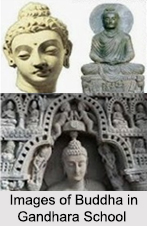 Gandhara School of Art and Sculpture occupies a high place in the history of Indian Art. This art form has played an important part in the development of the Indian art. Gandhara School of Art and Sculpture had developed in 1st century AD together with Mathura School in the sovereignty of Kushana ruler Kanishka. Both Shakas and Kushanas were patrons of Gandhara School of Art and Sculpture, which is recognized for the first sculptural demonstrations of the Buddha in human form. The art of the Gandhara School was chiefly Mahayana and shows Greco-Roman pressure.
Gandhara School of Art and Sculpture occupies a high place in the history of Indian Art. This art form has played an important part in the development of the Indian art. Gandhara School of Art and Sculpture had developed in 1st century AD together with Mathura School in the sovereignty of Kushana ruler Kanishka. Both Shakas and Kushanas were patrons of Gandhara School of Art and Sculpture, which is recognized for the first sculptural demonstrations of the Buddha in human form. The art of the Gandhara School was chiefly Mahayana and shows Greco-Roman pressure.
The Gandhara School of Art and Sculpture is also recognized as the Greco-Buddhist School of Art because Greek techniques of Art were applied to Buddhist subjects. The most significant gift of the Gandhara School of Art was the development of stunning images of the Buddha and Bodhisattvas, which were performed in black stone and modelled on equal characters of Greco-Roman pantheon. The most attribute quality of Gandhara sculpture is the representation of Lord Buddha in the standing or seated positions.
History of Gandhara School of Art and Sculpture
The sources of Greco-Buddhist art are to be found in the Hellenistic Greco-Bactrian kingdom (250 BC- 130 BC), situated in Afghanistan from which Hellenistic culture spread out into the Indian subcontinent with the institution of the Indo-Greek kingdom (180 BC-10 BC).
 Under the Indo-Greeks and the Kushanas, the interaction of Greek and Buddhist culture flourished in the area of Gandhara, in today"s northern Pakistan. Before spreading further into India and influencing the art of Mathura, the Hindu art of the Gupta Empire was extended to the rest of South-East Asia.
Under the Indo-Greeks and the Kushanas, the interaction of Greek and Buddhist culture flourished in the area of Gandhara, in today"s northern Pakistan. Before spreading further into India and influencing the art of Mathura, the Hindu art of the Gupta Empire was extended to the rest of South-East Asia.
Materials of Gandhara School of Art and Sculpture
Gandhara School of Art and Sculpture used Grey sandstone, green phyllite and gray-blue mica schist. The other materials used were Mud, Lime and Stucco. On the other hand, Marble was not used in Gandhara art. Stucco offered the artist with a standard of immense gracefulness, enabling a high degree of fluency to be given to the sculpture.
Mudras of Buddha in Gandhara Art and Sculpture
Gandhara School of Art and Sculpture has revealed making four types of hand signs and this is a remarkable feature in this art. The gestures are - Abhayamudra, Dhyanamudra, Dharmachakramudra and Bhumisparshamudra. In all the Buddha depicted in the Gandhara Art is shown making four types of hand gestures and this is a remarkable feature in this art.
Features of Gandhara School of Art and Sculpture
The Gandhara region had long been a crossroads of cultural influences. Gandhara school of Art was greatly influenced by Greek methodologies, the figures were more religious and sculpted chiefly in grey and great feature was paid to precise depiction of body parts. The Gandharan Buddha image was motivated by Hellenistic realism, tempered by Persian, Scythian and Parthian models.
Some of the chief features of the Gandhara style are the following:
1. The specimens were mostly prepared in stone, terracotta and clay.
2. The technique used in making the statues was Greek but, the idea, inspiration and personality all were Indian.
3. In this school of art, the life size statues of Gautama Buddha were first carved. Until then, the Buddhist existence was shown in the form of symbols like lotus, umbrella, etc
4. While carving the statues, utmost care was given to the symmetry of the body including the muscles and moustaches which were shown in a natural setting.
5. The folds and turns of the clothes were exhibited with minute care and skill.
6. The ornaments that were carved on the statues received much attention which added to the physical beauty of the statue.
7. Polishing the statues was an important feature of this art.
Themes of Gandhara School of Art and Sculpture
The theme of Gandhara School of Art and Sculpture is chiefly Buddhist, depicting a variety of stories from the life of Buddha. Sculptors constructed Buddhist images with anatomical correctness, spatial depth and foreshortening. The Buddha of Gandhara art is very thin, which is contrary to Mathura art. The images of Buddha looked like Greek God Apollo.
Gandhara School of Art and Sculpture gave more stress to the bodily features and external beauty. The varied characters of the Mathura School, a direct maintenance of the old Indian art of Bharut and Sanchi and the classical influence were derived from Gandhara. It had influenced the Amaravati Art also.



















